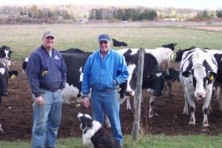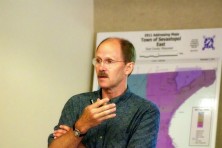Sustainable Agriculture in Door County
- Share
- Tweet
- Pin
- Share
Long ago, in 1985, a group of farm folks asked the Door County Environmental Council Board if the organization would like to become involved in the sustainable agriculture movement that was beginning to become active in Wisconsin.
As then president of the council, and as an active farm operator in southern Door County, I felt an extra urge to become involved in this new philosophy for reliable methods of farming, with less costly and less harmful chemical use and dependence.
With the Board’s approval it wasn’t long before we had organized a wide and varied group of interested farm people and secured the services of a coordinator to guide the efforts in the right direction.
Support and operational money soon became available from the State of Wisconsin Department of Agriculture; under grants from the oil overcharge funds held by the State, after the oil companies were found guilty of excessive profits.
We were off and running with some money and a hired coordinator. There was a lot of local interest by farmers wishing to cut down on their expenditures and have a more responsible way of keeping soil fertility at accepted levels.
This loose organization of farmers throughout the county and northeast Wisconsin was soon very active. They were radical thinking people with an eye on the future. I use the term radical because traditional “more-is-better” farm folks viewed this new thinking as contrary to the proper, progressive way to operate a farm and make money.
Others viewed sustainable farmers as “those organic people” who would slowly starve or go out of business because of such conservative resource management and because of the lessened use of artificial fertility with commercial fertilizer.
They were wrong on both counts; sustainable farmers still used commercial fertilizer and herbicides but were more selective and disciplined with their use of natural supplements.
Real organic farming is an entirely different concept as it is a labor-intensive method of making use of natural processes and use of natural fertility supplementation. There is a big difference but the two sometimes go hand-in-hand, adding to the past confusion.
The organization grew and became well known statewide with a big following of dedicated farm people throughout northeast Wisconsin. The farmer network became more visible with the beginning of a series of Sustainable Agriculture Institute classes held each week throughout the winter.
Farm folks looked forward to these “classes” as a reliable source of new information with presenters from as far away as New Zealand. A statewide sustainable agriculture gathering was held in Door County with a two-day festival on the Don Rudolph farm north of Sturgeon Bay. Speakers with varied expertise came to share their knowledge to benefit the sustainable group and those others who came out of curiosity.
All this happened while opponents of sustainable farming methods were having a fine time trying to hold this new limited input farming method accountable far beyond the expectations of the conventional farming methods.
They expected miracles, and miracles didn’t happen. Sustainable methods caught on for many of the farmers of the county, who were good with management practices that supported sustainability. Rotational grazing, firm dedicated rotation of crops, natural legume nitrogen generation, proper animal waste utilization and control, and a host of other practices are still in use today on many of the sustainable farms continuing from those early days.
Some of the farm operators, who were lacking in good management skills, had hoped that becoming sustainable would carry them through their difficult financial times. They were disappointed, as no miracles happened to help them through their difficulties and they eventually changed occupations.
Those who were, and are successful managers, continue on with sustainable practices today and are operating in the black, much to their credit and vision.
The changes that have taken place in the last decade in agriculture have limited sustainable participation because of the trend toward larger farm operations with, in most cases, hired management and goals to meet for production and ultimate profit.
The often-heard argument that farms need to be bigger to survive has effectively caused a decline in small family farms and changed our entire agricultural future.
Other groups soon picked up on sustainable thinking with the Chamber of Commerce adopting a “sustainable tourism” promotion with the thoughts of keeping the image of a quaint, picturesque location as a prime destination for visitors.
The local development faction cheerfully locked onto the catchy phrase and the concept also with “sustainable development” as a way to create a more acceptable image and to lessen the public reaction to proposed projects. More recently, a new movement has been present in this country and in our county to incorporate concepts of sustainable communities.
The mind-set of citizens has been changing through the years and this concept from other countries is being accepted. This is shift is due to the efforts of dedicated people, working to make responsible and sustainable communities part of our heritage in this great part of Wisconsin.
Door County Environmental Council is proud to be a supporter of these efforts that will soon bring about some needed changes in the drive to keep our communities vibrant and desirable into the next generations. The movement is long past due!
Become involved in changing the way your own community plans to enable it to prosper and grow responsibly and be truly sustainable.
For more information call 920.743.6003, email [email protected] or visit http://www.dcec-wi.org.


